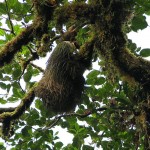Maybe it’s the advent of the rainy season here on the Northwest Coast, the time of all things mouldy and green. Or maybe it’s just the battle I wage every morning to crawl out of bed when it’s still so bloody dark. But sloths strike me as very simpatico these days.
Ok, if you watch this video–which I heartily recommend–you may feel a little repelled by a creature that can’t be bothered to wave away the large insects roaming its nostrils or dispose of the moths that flutter about its fur. But rise above your antipathy. The latest thinking among biologists is that the sloths are masters of energy conservation.

See, sloths live in a difficult environmental niche–the forest canopies in Central and South America, where a host of predators are constantly on the prowl for a cheap meal. To avoid becoming so much sloth tartar, the treetop dwellers try to blend into the canopy, moving as little as possible.
Treetop living, however, has its drawbacks. The vegetation there isn’t very nutritious, so sloths have to conserve energy. One way of doing this is to dispense with costly muscle mass. Sloths have half as much brawn as other mammals of similar size. And to slash energy costs further, they turn down the thermostat. While dogs, pigs and many other mammals maintain body temperatures of at least 100 degrees Fahrenheit, sloths average a cool 93 degrees. If things start getting chilly at night, sloths warm up in the morning by basking like reptiles in the sun.
But one of the best parts about sloths is the clever symbiotic thing they do with algae. Sloths give algae a moist place to live–in the deep grooves that run along sloth hairs. In return, green algae help to camouflage the sloth and supply the odd fast meal.
Europeans first encountered sloths in the forests of New World in the 16th century and they so despised these creatures that they named them after one of the seven deadly sins. Today we see them as they really are, eco-wonders of a sort, green in every sense of the word.
Photo courtesy of D. Gordon E. Robertson